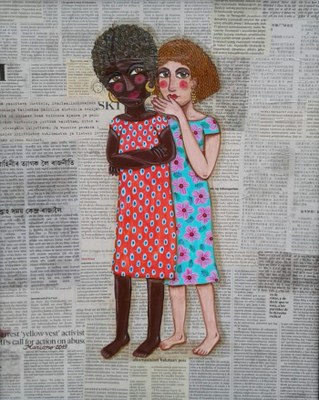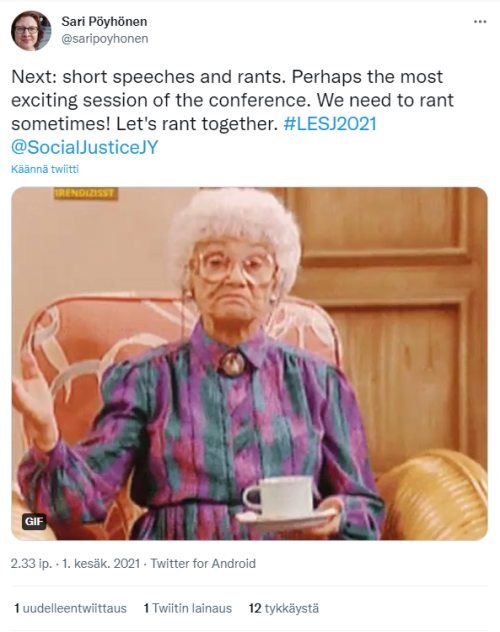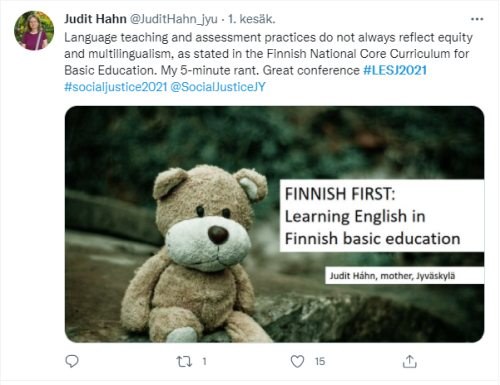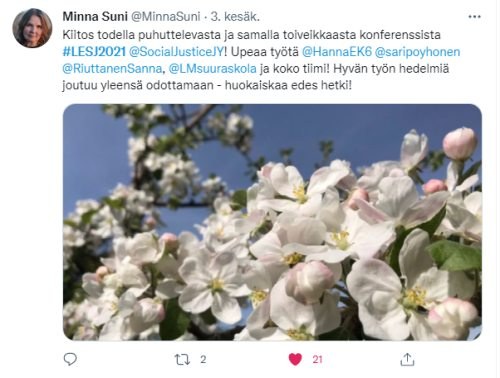Creating a hopeful and diverse conference – report from LESJ2021
The morning of June 1 was warm and summery as we arrived at the Centre for Applied Language Studies in Mattilanniemi, Jyväskylä. The first day of the virtual conference Language Education for Social Justice (#LESJ2021 in Twitter) had finally come, an event we had started planning over two years earlier, before the Covid-19 pandemic began. The Zoom links were up, the web cams polished, and the virtual backgrounds on. We were ready to go! Over 240 participants from 23 countries had registered to the conference, which was the first of its kind (at least to our knowledge).
Our conference opened with greetings from the conference chairs, the university’s vice rector Marja-Leena Laakso, Language Campus doctoral researchers Päivi Iikkanen and Magdalini Liontou, and the conference secretaries Sanna Riuttanen and Laura-Maija Suur-Askola. Sari Pöyhönen and Johanna Ennser-Kananen reminded us of the purpose of this event:
“Both education and language have been and are being used to colonize, to exert domination, oppression, erasure, hierarchies, discrimination - in short, injustice. (And yes, they have also been used as tools of equity, but that is a lot more commonly acknowledged and talked about.) As in many contexts, here in Finland, there is no point in history at which all languages, all its speakers, all learners, all students, or all teachers, were equal. This event wants to contribute to a change for the better, a change towards Language Education for Social Justice.”
More than a hundred people followed the opening ceremony and the subsequent first keynote by Lou Harvey from the University of Leeds. Lou talked about the role of language, voice and understanding in peace education and how transrational approach can offer a framework to emotional, embodied, collective, aesthetic and metaphysical aspects of learning in peace education. Hän puhui myös siitä, miten taidelähtöiset menetelmät voivat auttaa ymmärtämään oppimista ja pienentämään kielen keskeisenä pitämäämme asemaa oppimisessa ja vuorovaikutuksessa.
Setting up a supportive and safe event
After the keynote came the first real test of our Zoom connections – 7 parallel paper sessions were about to begin. We had decided to keep these separate, so instead of 7 breakout rooms in one Zoom, we had 7 Zooms running simultaneously on 7 university computers. The upside of this was that moving from one session to another was as simple as clicking a link in the programme. The first parallel sessions featured presentations especially for teachers.
As part of creating a safe environment for all participants, each parallel session began with the session chair reminding everyone of the safer space rules.

The participants were asked to report rule breaks to the conference chairs. Luckily, no such rule breaks were reported. Instead, we found moments of conviviality and epistemic solidarity.
The support from the Language Campus conference team was incredibly important in making the conference happen and creating a safe space for all participants. A special thank you must go to the Language Campus doctoral researchers, who were instrumental in putting the event together, who hosted many of the sessions and actively participated in them. Another huge thanks goes to our graphic designer Pasi Ikonen, who created our beautiful programme & programme booklet.
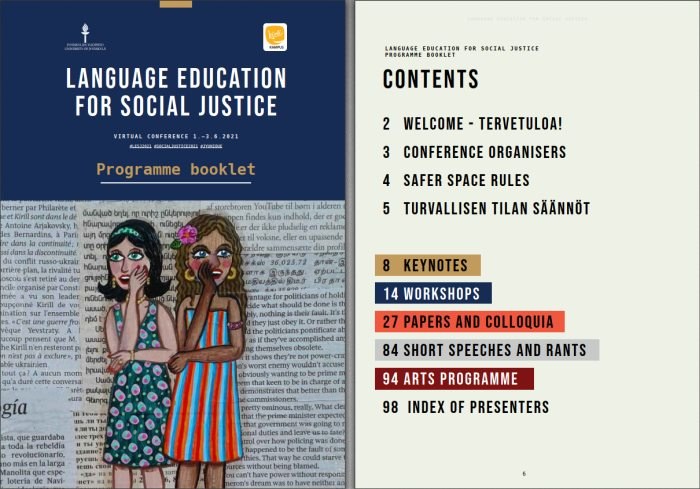
The beautiful artworks by naivist artist Luciana Mariano were featured throughout our conference website and promotion materials, and we were so happy to see Luciana also in our audience.
Rants and sports in an academic conference
New experiment in the programme were short speeches and rants, 5-minute presentations with 5-minute discussions. We created this genre specifically for this conference, because we realized that thoughts on language education and social justice sometimes need to come out as a rant.
These short speeches ranged from passionate calls for change to calm and analytical discussions, each presenter doing what felt right for them. Without the restrictions of traditional academic paper presentations, our ranters were incredibly creative.
Räntit käsittelivät muun muassa monikielisyyttä ja oman äidinkielen opetusta, rodullistetun traumaa, CLIL-opetusta ja erityistä tukea tarvitsevien oppilaiden asemaa. Given their positive reception and in the spirit of making emotions more legitimate in the academy, we plan to keep ranting and providing spaces for it also after the conference.
Before the next keynote, we had a break involving something very Finnish – taukojumppa (exercise break)! Shoutout to the University Sports uMove for the most fun and energetic exercise break host we could have asked for. Who knew how good it could feel to look a bit silly in the company of 100 other conference participants ;-).
The second keynote was given by Venla Bernelius from the University of Helsinki, who talked about segregation, migrant communities and educational opportunities in Finnish cities. The academic programme for Day 1 concluded with two-hour workshops that dealt with multilingual pedagogy, transformative language education in beginner level classes, translanguaging, and group reflection.
Paintings, dance, songs, videos, and interviews – taide liikuttaa
The highlight of the first day was the evening programme. We had managed to gather an amazing arts programme for the conference, a line-up devoted to issues of social justice. Some of the art was available for the duration of the conference, as videos produced in Crossing Borders project (see the project art gallery here) and an online art gallery “Visual Representations of Multilingualism” curated by Dr. Jessica Bradley from the University of Sheffield (gallery’s website), and an online art gallery of drawings and paintings by Jalil Jahari (view it behind the link).
As part of the evening programme, we saw a dance performance Hulda Rankanen, watched a short film of Toinen koti – Other Home documentary theatre performance (link), listened to interviews with an actor and media producer Harith Raad Salih and a young visual artist Jalil Jahari, and heard three beautiful songs performed live by the local choir Kipinät. It is fair to say that the conference participants, ourselves included, were not indifferent to social justice-themed art.
After the first day, we all felt exhausted but happy. The tech had worked, the people had showed up and presented great research, and, maybe most importantly: there was a palpable (and often commented on) sense of community and togetherness despite the physical distance between us all. Days two and three went by smoothly as the success of the first day carried us.
Our third keynote, Aminkeng Atabong Alemanji from University of Helsinki, talked about spiral trajectories of racism and possibilities to develop antiracist pedagogy in the Finnish education system. Luento oli vaikuttava: Alemanji kytki antirasistisen pedagogiikan lähtökohdat henkilökohtaisiin kokemuksiinsa niin opettajana, opiskelijana kuin vanhempana ja tarjosi konkreettista evästystä, miten Suomessa voitaisiin toteuttaa antirasistista pedagogiikkaa. Alemanji’s keynote was commented by Mel Engman from Queen’s University of Belfast bring viewpoints from minority and indigenous language communities.
The final keynote was given by Birgül Yilmaz from the University College London. Hänen luentonsa käsitteli pakolaisten opetusta Kreikan Lesbos-saarella. Her talk was a powerful example of linguistic ethnography in a forced migration setting, and how humanitarian governmentality operates in a NGO’s language learning and teaching and how this kind of technique was challenged by young refugees.
Signs of hope
The programme consisted of sessions on an immense amount of topics. These included culturally responsive teaching and multilingual pedagogies, critical content based instruction, teachers’ beliefs, perceptions and practices, language policies and language policing, minoritized learners and indigenous communities, multilingual learners, learners with special needs, newly arrived learners, questions of power, gender, race, ethnicity and religion, trauma and socio-emotional support, curricula and language education policies, digital literacies, and language assessment. In other words, it was a wonderfully diverse range of topics and discussion, all with the goal of making language education more equitable.
At the end of Day 3, we concluded the event with a very emotional ceremony which left us all feeling extremely grateful about the community surrounding us at the Language Campus and beyond. Here is an excerpt from the last speech by Sari Pöyhönen and Johanna Ennser-Kananen:
“During these past 3 days, we saw many signs of hope:
- We saw colleagues jumping in at a moment’s notice for someone else and solving problems at lightning speed.
- We saw people acknowledge their privilege and genuinely seek ways to make space for those less privileged.
- We saw people joke about their similar experiences, laugh about their differences, and people -who are in other contexts competing for resources- bond over the work that needs to be done.
- We noticed that arts can support, challenge and question the current state of affairs. We saw people deeply moved and changed by art.
We think of this conference as a beginning or continuation of a conversation, not as the end of it. Let’s be hopeful, but not complacent. Let’s keep working for change in our contexts, our institutions, and ourselves and push for language education for social justice.”
Two special issues coming up
After we had cheered in the hallways, our inboxes and Twitter feeds started to fill up with virtual thank yous and compliments for the conference. A contact list was set up for the participants, to encourage future collaborations, some of which have already taken concrete shape.
This is what a (virtual) conference should be: a thought-provoker, a community builder, and a safer space for all. We are looking forward to continuing with the theme of social justice this fall with two special issues in two journals – Apples –Journal of Applied Language Studies and Kieli, koulutus ja yhteiskunta.
Writers:
Sanna Riuttanen, conference co-secretary
Johanna Ennser-Kananen, conference chair
Sari Pöyhönen, conference chair
Editing by Pasi Ikonen, Language Campus coordinator
